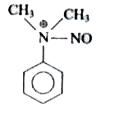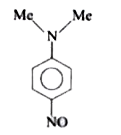Assertion (A) : couples with -dimethyl aniline (I) but not with -dimethyl--dimethuyl aniline (II)
Reason (R ): Due to steric inhibition of resonance , the p-position of (II) is not sufficiently activated fro the coupling reaction.
If both (A) and (R ) ar true, and (R ) is the correct explanation of (A).
If both (A) and (R ) are true , and (R ) is not the correct explanation of (A).
If (A) is true , but (R ) is false .
If both (A) and (R ) are false .
The correct Answer is:A
To solve the problem, we need to analyze the assertion and reason provided in the question regarding the coupling of diazonium salts with two different anilines.
1. Understanding the Assertion (A):
- The assertion states that the compound Ph−(⊕)(N2)BrΘ couples with N,N-dimethyl aniline (I) but does not couple with 2,6-dimethyl N,N-dimethyl aniline (II).
- Here, Ph represents a phenyl group, and N2 indicates a diazonium group. The coupling reaction involves the formation of a new bond between the diazonium salt and the aniline.
2. Analyzing Compound I (N,N-dimethyl aniline):
- In the case of N,N-dimethyl aniline, the nitrogen atom has two methyl groups and a lone pair.
- The lone pair on the nitrogen can participate in resonance with the benzene ring, enhancing the nucleophilicity of the para position.
- This allows the para position of the benzene ring to be activated, facilitating the coupling reaction with the diazonium salt.
3. Analyzing Compound II (2,6-dimethyl-N,N-dimethyl aniline):
- For 2,6-dimethyl N,N-dimethyl aniline, the two methyl groups are positioned ortho to the amino group.
- These bulky methyl groups create steric hindrance, which affects the ability of the lone pair on the nitrogen to participate in resonance with the benzene ring.
- The steric hindrance causes the nitrogen's lone pair to be less available for resonance, leading to a situation where the para position is not sufficiently activated for the coupling reaction.
4. Understanding the Reason (R):
- The reason states that due to steric inhibition of resonance, the para position of compound II is not sufficiently activated for the coupling reaction.
- This is a correct explanation for why the coupling does not occur with compound II, as the steric hindrance prevents effective overlap between the lone pair on nitrogen and the π system of the benzene ring.
5. Conclusion:
- Both the assertion and the reason are true, and the reason correctly explains the assertion. Thus, the answer is that both statements are correct.
Final Answer:
Both Assertion (A) and Reason (R) are true, and R is the correct explanation of A.
---
- The assertion states that the compound Ph−(⊕)(N2)BrΘ couples with N,N-dimethyl aniline (I) but does not couple with 2,6-dimethyl N,N-dimethyl aniline (II).
- Here, Ph represents a phenyl group, and N2 indicates a diazonium group. The coupling reaction involves the formation of a new bond between the diazonium salt and the aniline.
- In the case of N,N-dimethyl aniline, the nitrogen atom has two methyl groups and a lone pair.
- The lone pair on the nitrogen can participate in resonance with the benzene ring, enhancing the nucleophilicity of the para position.
- This allows the para position of the benzene ring to be activated, facilitating the coupling reaction with the diazonium salt.
- For 2,6-dimethyl N,N-dimethyl aniline, the two methyl groups are positioned ortho to the amino group.
- These bulky methyl groups create steric hindrance, which affects the ability of the lone pair on the nitrogen to participate in resonance with the benzene ring.
- The steric hindrance causes the nitrogen's lone pair to be less available for resonance, leading to a situation where the para position is not sufficiently activated for the coupling reaction.
- The reason states that due to steric inhibition of resonance, the para position of compound II is not sufficiently activated for the coupling reaction.
- This is a correct explanation for why the coupling does not occur with compound II, as the steric hindrance prevents effective overlap between the lone pair on nitrogen and the π system of the benzene ring.
- Both the assertion and the reason are true, and the reason correctly explains the assertion. Thus, the answer is that both statements are correct.
Both Assertion (A) and Reason (R) are true, and R is the correct explanation of A.
Topper's Solved these Questions
- BOOK - CENGAGE CHEMISTRY ENGLISHCHAPTER - ORGANIC COMPOUNDS WITH FUNCTIONAL GROUPEXERCISE - Archives Single Correct10videos
ORGANIC COMPOUNDS WITH FUNCTIONAL GROUP
- BOOK - CENGAGE CHEMISTRY ENGLISHCHAPTER - ORGANIC COMPOUNDS WITH FUNCTIONAL GROUPEXERCISE - Archives Assertion-Reasoning2videos
ORGANIC COMPOUNDS WITH FUNCTIONAL GROUP
- BOOK - CENGAGE CHEMISTRY ENGLISHCHAPTER - ORGANIC COMPOUNDS WITH FUNCTIONAL GROUPEXERCISE - Exercises Single Correct51videos
ORGANIC COMPOUNDS WITH FUNCTIONAL GROUP
- BOOK - CENGAGE CHEMISTRY ENGLISHCHAPTER - NUCLEAR CHEMISTRYEXERCISE - Archives Subjective13videos
NUCLEAR CHEMISTRY
- BOOK - CENGAGE CHEMISTRY ENGLISHCHAPTER - P-BLOCK GROUP 15 ELEMENTS - THE NITROGEN FAMILYEXERCISE - Exercises Archives (Subjective)28videos
P-BLOCK GROUP 15 ELEMENTS - THE NITROGEN FAMILY
Similar Questions
Assertion (A): 2,6-Dimethyl-4-nitrophenol (I) is more acidic than 3,5-dimethyl-4-nitrophenol (II).
Reason (R ): It is due to the steric inhibition of the resonance of (−NO2) group with two (Me) groups in (II).View SolutionAmong N N dimethyl aniline and N, N, 2, 6 - tetramethyl aniline which one is a stronger base and why
View Solution
Knowledge Check
- Question 1 - Select One
N,N-dimethyl aniline react with NaNO2 and dilute HCl at 0−5∘C to form :
A B
B C
C D
D
Assertion : N, N-Diethyl ethanamine is more basic the N, N-Dimethyl methanamine.
Reason : +I effect of ethyl group is more then methylView SolutionN-butylamine (I), diethylamine (II) and N,N-dimethyl ethylamine(III) have the same molar mass. The increasing order of their boiling point is:
View SolutionStatement 1: N, N-dimethyl aniline does not react with nitrous acid, whereas aniline react with nitrous acid.
and
Statement 2:N, N-dimethy aniline is more basic than aniline.View SolutionHow will you convert
(i) Benzene into aniline (ii) Benzene into N, N-dimethylaniline
Cl−(CH2)4- Cl into hexane- 1,6- diamine ?View SolutionAssertion (A) : The ionisation energy of N is more than that of O
Reason (R ) : Electronic configuration of N is more stable due to half - fillied 2p orbitalsView SolutionN2O3R.T.−−→NO+NO2
View SolutionN2O3R.T.−−→NO+NO2
View Solution

